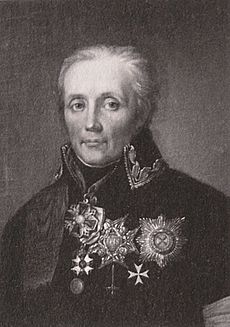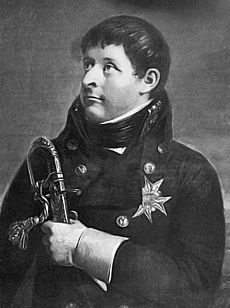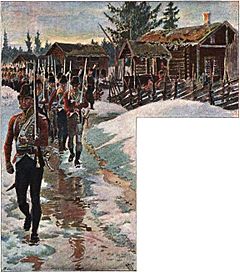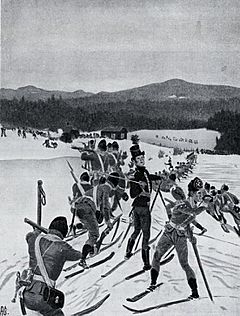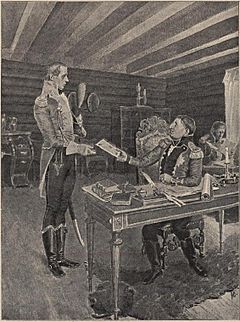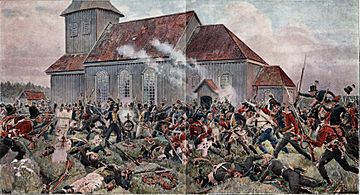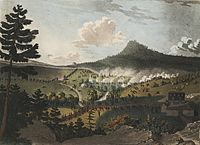Dano-Swedish War of 1808–1809 facts for kids
Quick facts for kids Dano-Swedish War of 1808–1809 |
|||||||
|---|---|---|---|---|---|---|---|
| Part of the Napoleonic Wars and the English Wars | |||||||
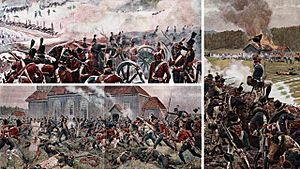 Clockwise from top: |
|||||||
|
|||||||
| Belligerents | |||||||
|
Supported by: |
|||||||
| Commanders and leaders | |||||||
|
|
||||||
| Strength | |||||||
| Denmark–Norway: 36,000 French Empire: 45,000 Total: 81,000 |
23,000 | ||||||
| Casualties and losses | |||||||
|
|
||||||
The Dano–Swedish War of 1808–1809 was a conflict between Denmark–Norway and Sweden. It happened because Denmark–Norway was allied with France, while Sweden was allied with the United Kingdom. This war was part of the bigger Napoleonic Wars that swept across Europe.
Neither country really wanted to fight at first. But their alliances pushed them into it. Sweden hoped to take over Norway. Denmark–Norway tried to win back lands they had lost to Sweden in the 1600s. The war ended on December 10, 1809, with a peace treaty that meant both sides kept their original territories.
Why the War Started
Neutrality and Alliances
For a while, Denmark–Norway and Sweden tried to stay neutral in the big European wars. They even formed a group called the Second League of Armed Neutrality in 1800. This group aimed to protect their ships from being searched by the British. However, this group broke up after the Battle of Copenhagen in 1801.
Later, in 1805, Sweden joined the war against France. But French forces quickly advanced and occupied Swedish Pomerania, a Swedish territory. France then offered Sweden Norway if Sweden would give up Swedish Pomerania. But this deal didn't happen.
Denmark Joins France
In 1807, France and Britain turned their attention to Denmark. French Emperor Napoleon wanted Denmark–Norway to join his trade blockade against Britain, called the Continental System. Britain worried that Denmark's navy would fall into French hands.
So, Britain attacked and bombed Copenhagen in 1807. They captured and destroyed much of the Danish fleet. This forced Denmark to make an alliance with Napoleon. This alliance was signed on October 31, 1807. France vaguely promised to help Denmark get its fleet back. In return, Denmark had to agree to fight Sweden if needed.
Plans for Invasion
Crown Prince Frederik of Denmark–Norway didn't really want to fight Sweden. But he decided to declare war anyway. His goal was to take back lands Denmark–Norway had lost to Sweden in earlier treaties. He thought it would be easy because Sweden was busy fighting Russia in the Finnish War in Finland.
On March 14, 1808, Denmark declared war on Sweden. The Swedish king, Gustav IV Adolf, planned to invade a Danish island called Sjælland. This was to force Denmark to make peace. But he changed his mind when he heard rumors of French troops helping Denmark. Instead, King Gustav IV approved a plan to invade Norway. This was to make up for any land Sweden might lose in Finland.
The Armies
Swedish Forces
The Swedish army in Sweden had about 23,000 soldiers.
- 7,000 men were in southern Sweden, led by Count Johan Christopher Toll.
- 14,000 men were near the Norwegian border, led by Gustaf Mauritz Armfelt.
- 2,000 men were in Norrland, led by Johan Bergenstråhle.
The Swedish soldiers were well-trained and had good equipment. But Sweden was fighting on two fronts, against Russia in the east and Denmark–Norway in the west. The main fighting was in Finland. The Swedish army on the western border was split into two parts.
Danish-Norwegian Forces
The Danish-Norwegian army had a total of 36,000 men.
- The Danish army had about 14,650 men. Only 5,000 of these could be used for attacks.
- The Norwegian army had been preparing for war since late 1807. But they also had to protect the long Norwegian coast from the British navy. This meant the army was not in good shape in early 1808. They lacked weapons, ammunition, clothes, and food. Much of their equipment was very old.
The Norwegian army was led by Prince Christian August. He was in charge of the Norwegian government at the time.
Norwegian Army Structure
The Norwegian army included different types of soldiers:
- About 1,800 dragoons (soldiers on horseback).
- About 8,400 musketeers (infantry with muskets).
- About 1,200 sharpshooters.
- About 5,000 depot soldiers (reserve troops).
- About 4,800 grenadiers (elite infantry).
- Artillery units for fortresses and in the field.
- Ski battalions and jäger (hunter) battalions.
- A light battalion and a pioneer company.
At the start of the war, Prince Christian August had only 8,000 men ready along the border. Many new, untrained recruits had to join to fill the ranks.
Norwegian Border Defense
Christian August divided his southern forces along the border from south to north:
- Colonel Hans Gram Holst had about 3,400 men in the south.
- Colonel Werner de Seues had about 1,900 men in the center.
- Colonel Bernhard Ditlef von Staffeldt had about 1,300 men in the north.
- Two reserve brigades, led by Colonel Christopher Frederik Lowzow and Colonel Johan Andreas Cornelius Ohme, had about 2,350 men.
In total, about 9,000 Norwegian soldiers defended the south. Another 3,300 men were in Trøndelag in the north. There were also soldiers stationed in cities like Trondheim, Kristiansand, Frederiksvern, and Bergen.
Fortress Garrisons
Important fortresses also had soldiers:
- Fredrikstad: about 2,350 men
- Fredriksten: about 1,250 men
- Kongsvinger Fortress: about 900 men
- Akershus Fortress: about 800 men
French Support
Napoleon sent about 45,000 soldiers to Denmark. These included French, Spanish, and Dutch troops, plus a Danish reserve. This meant the Danish-French force had about 81,000 men. The French insisted that their commander, Marshal Jean-Baptiste Bernadotte, lead the combined army.
War Preparations
Marshal Bernadotte began marching his army towards Denmark in early March. However, Napoleon seemed unwilling to let his troops fight right away. Bernadotte's army camped on the Danish island of Sjælland.
Then, British warships arrived surprisingly early in mid-March. This meant Bernadotte couldn't move his troops across the water before the British navy blocked the way.
The large number of foreign troops in Denmark became a problem for the Danish people. Also, news arrived that Spain had rebelled against Napoleon. So, the Spanish troops in Denmark had to be disarmed and held. By mid-April 1808, the plan for a French-Danish invasion of Sweden was called off. Instead, attention turned to the border between Sweden and Norway.
The War Begins
Swedish Invasion of Norway
In late March, small fights broke out along the Norwegian-Swedish border. The first big action happened on April 1, 1808. Swedish Major Johan Bergenstråhle marched 2,000 men into Norway from Jämtland. But they had to retreat without a major battle.
At the same time, a smaller Swedish force entered Norway from Herjedalen. They fought a small group of Norwegian guards near Røros. The Swedes then looted the town of Brekken. Norwegian forces under Major Sommerschild counterattacked and pushed the Swedes back.
In return, Norwegian forces crossed into Sweden on April 8. They looted Swedish properties and took back items stolen from Brekken. After these early fights, the border area in the north became quiet. So, Norway sent more troops south.
The main Swedish attack in the south began on April 14. Swedish troops advanced into the Aurskog-Høland area. Prince Christian August moved his headquarters to meet this threat. He used his forces cleverly to defend against the Swedish attacks.
Fighting in Høland and Aurskog ended with a Norwegian victory. The Swedish commander, Colonel Schwerin, ordered a retreat after his troops were defeated at battle of Toverud. Christian August then moved his forces to Kongsvinger to prepare for a larger attack.
Fighting Around Kongsvinger
On April 15, Swedish General Gustaf Mauritz Armfelt advanced with about 1,600 men towards Kongsvinger. They pushed back the Norwegian border guards. On April 18, a battle took place at Lier, near Kongsvinger. About 1,000 Swedish soldiers defeated 800-900 Norwegians.
After this win, the Swedes dug in at Lier and reached the Glomma river. But they did not attack Kongsvinger Fortress. This stopped their advance for a while.
Christian August was worried by the defeat at Lier. He moved his main forces to Blaker to stop any further Swedish attacks. Luckily, Norwegian victories elsewhere helped stabilize the situation. Armfelt then planned to surround and attack Kongsvinger. He ordered Colonel Carl Pontus Gahn to move his troops to Glomma and then towards Kongsvinger. This was meant to be a pincer movement to trap the fortress.
Colonel Gahn's march was risky. He had to pass strong Norwegian forces. On April 24, Gahn marched with about 500 men towards the Flisa river. Norwegian forces, including Colonel Staffeldt's brigade, attacked the Swedes from behind.
The battle of Trangen was a big defeat for the Swedes. About 440 Swedish soldiers were captured. After this, Colonel Staffeldt's brigade moved to Kongsvinger to strengthen the fortress defense. Christian August then went south to plan an attack in the Ørje area.
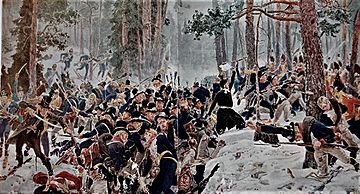
When Armfelt heard about the defeat at Trangen, he worried about a Norwegian attack on his flank. Strong Norwegian forces were now at Kongsvinger and Blaker. So, Armfelt decided to wait for more Swedish troops before continuing his operations. He chose to take a defensive position.
Battles in Smaalenene
Christian August had planned to attack the Swedish forces at Ørje. But he received news that a Swedish attack from the south was coming. From May 2-3, about 2,000 Swedish soldiers advanced in three groups towards Fredrikshald. But they were stopped by Norwegian defenses.
Further north, another Swedish force of about 1,000 men advanced towards Aremark. This attack was also stopped. During May, Swedish troops dug in along a line from southeast of Kongsvinger to Iddefjorden.
The planned Norwegian attack was changed to a smaller one. About 1,000 men, led by Major Andreas Samuel Krebs, attacked the Swedish brigade at Ørje on May 4. The fighting around Aremark on May 5 was tough. The Swedish troops eventually retreated to their strong positions outside Ørje.
The Norwegians had 10 wounded, while the Swedes had 10 dead and 16 wounded. Other small attacks were made against Swedish positions. On May 9, Norwegian Lieutenant Johan Spørck attacked a Swedish position near Fredriksten fortress, but was pushed back.
Swedish Withdrawal from Norway
After Colonel Staffeldt reorganized his forces at Kongsvinger, the front there was quiet. Only small fights happened, which bothered the Swedes. On May 5, a Swedish advance guard was wiped out, and 10 Swedes were captured. These small attacks made the Swedish commander concentrate his troops more.
The Swedes also brought siege artillery to the Kongsvinger front for a new attack. They built new defenses. But the Norwegians kept a close watch, sending out patrols. Major troop movements were difficult until mid-May because of heavy snow. On May 15, Staffeldt planned a larger attack on the Swedish right side, but it was delayed until May 18.
Battles at Mobekk and Jerpset
The fight at Mobekk didn't go well for the Norwegians. The Swedes destroyed a key bridge, and the Norwegians couldn't cross. After four hours, the battle ended, and the Norwegians returned to Kongsvinger.
To make up for this, Staffeldt planned a new attack. He learned that a Swedish jäger (hunter) company was at Jerpset. On May 23, Norwegian troops, including 65 skiers, crossed the Glomma river. They attacked Jerpset farm on May 24. They found only 29 Swedish soldiers there, and captured 25 of them.
This attack at Jerpset worried Armfelt so much that he ordered a retreat from the positions closest to Kongsvinger. He had also received an order from King Gustav IV Adolf on May 19, which he thought meant a general retreat.
A British fleet with 10,000 men arrived in Gothenburg on May 18. King Gustav IV Adolf wanted to launch a joint Swedish-British attack on the Danish island of Sjælland. He ordered Armfelt to take a safe defensive position in Norway. However, Armfelt misunderstood the order. He abandoned all attack plans and retreated his troops behind the border.
The Swedish retreat surprised the Norwegians. Staffeldt advanced his troops to Eidskog and Matrand. King Gustav IV Adolf's plan for a Swedish-British attack on Sjælland was canceled when the British navy returned to England on July 3.
Fighting in Enningdal
The other two Swedish brigades near Fredrikshald also retreated across the border in early June. By mid-June, only two Swedish positions remained in Norway. Christian August had planned a big attack to push the last Swedish troops out. But the plan was changed to smaller attacks.
These attacks were led by Captain Arild Huitfeldt. On June 9, he advanced with 710 men. During the battle of Prestebakke on June 10, Huitfeldt confused the Swedish officers. He surprised and defeated the Swedish forces.
The Swedes lost 60 dead or wounded, and 395 were captured. A smaller force of about 150 men surrendered. The Norwegians had only about 12 casualties. This defeat shocked the Swedes, and their commander was put on trial.
The Swedes received reinforcements and counter-attacked Prestebakke on June 14. The main Norwegian force had moved back to Fredriksten fortress with the prisoners. So, the outnumbered Norwegian outposts were pushed back. But the Swedes then left their positions and went back across the border between June 20-24. Norwegian forces quickly secured the border areas. This meant there were no longer any Swedish troops on Norwegian soil.
Small Attacks and Campaigns
From June to December, there were several small attacks from both sides. But these didn't change the war much. Norwegian soldiers along the border faced boredom and poor conditions. They often lived in simple huts and had little food.
Norwegian raids on Swedish civilians were not allowed. Officers on both sides wanted their soldiers to treat civilians well. But food was scarce, and supplies were low. This made soldiers on both sides feel tired and discouraged.
Attacks into Sweden
Major General Staffeldt, who was promoted on June 30, kept his troops at the border. In early July, they were ordered to make small attacks into Sweden. One group of 200 men advanced into Sweden on August 10. They returned on August 20 after finding no Swedish troops.
In August 1808, 644 Norwegian troops from Trøndelag advanced into Jämtland in Sweden. Staffeldt also sent troops to support this invasion. But the main Norwegian attack into Jämtland was stopped on August 15. The Swedish troops had strengthened their defenses. The campaign ended on August 19.
Ceasefire
The British navy's blockade made things worse for Norway. Supplies from Denmark and Russia were not enough. There were shortages everywhere. Soldiers lacked uniforms and equipment. It was hard to launch more attacks. So, Christian August decided to keep his troops at the border.
Things were also difficult for the Swedes. Most supplies went to the war against Russia in Finland. Lieutenant General Bror Cederström took over command of the Swedish border army from Armfelt.
In the autumn, Christian August and the Swedes began talks. Christian August felt he couldn't continue fighting because of the lack of supplies. So, against his king's wishes, he agreed to a ceasefire for the southern Norwegian front on November 22. The agreement started on December 7, 1808. It could be ended with 48 hours' notice, but it lasted for the rest of the war.
The ceasefire came too late for both armies. Many soldiers suffered from diseases like typhoid and dysentery. In the Norwegian army, about half of the 17,000 soldiers got sick. Between April and September, 700 died. By March 1809, about 8,700 were in hospitals, and 1,200 of them died.
The Swedish army had even worse conditions. Many soldiers died from diseases.
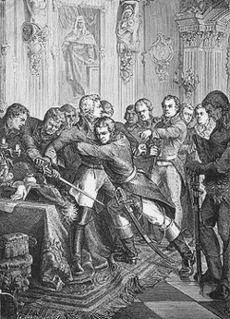
In the winter of 1808–1809, there were no major battles. Norway lacked supplies. Sweden was focused on the war in the east, where Russia had taken over Finland. At the same time, people in Sweden were unhappy with their king, Gustav IV Adolf. They wanted a new constitution.
Swedish leaders worried that Norwegian troops might invade Sweden during this time of unrest. So, they made sure the ceasefire agreement was still valid. This was confirmed in the Kongsvinger Agreement in March 1809. It was an oral agreement that Norwegian troops would stay at the border. Meanwhile, Swedish forces marched to Stockholm to remove King Gustav IV. Many Norwegians, especially Christian August, supported this change. Christian August was even considered a possible new king of Sweden.
On March 7, 1809, the revolution began. King Gustav IV Adolf was arrested on March 13 and imprisoned. His uncle, Charles XIII, became the new King of Sweden on June 5. The next day, a new constitution was passed.
Fighting in Jämtland (1809)
Christian August was not eager to attack Sweden in the spring of 1809. But King Frederik VI pushed him to do so. On July 2, Christian August ordered an attack on Jämtland from Trondheim. On July 10, 1,800 men, led by Major General Georg Frederik von Krogh, crossed the border.
To stop them, Swedish General Georg Carl von Döbeln was sent to Jämtland. Other Swedish troops also arrived. On July 16, the Norwegians captured a Swedish defense point. They also took the villages of Mörsil and Mattmar. But then, a rumor spread that Sweden and Russia were making peace. Von Krogh decided to retreat and attack Härjedalen instead.
On July 24, 900 Swedish soldiers met 1,800 Norwegian soldiers in Härjedalen. The Norwegians were defeated and had to retreat. A ceasefire was signed the next day. It stated that all Norwegian troops must leave Sweden by August 3, which they did.
Aftermath
In Norway, the situation got worse because of the British blockade. They no longer received supplies from Russia, as Russia had made peace with Sweden on September 17. Sweden's war on two fronts had also been very hard on its people and soldiers.
Both sides wanted peace. Negotiations began in November.
Treaty of Jönköping
On December 10, 1809, representatives from Denmark–Norway and Sweden met in Jönköping. They signed a peace treaty that ended the war. The treaty said:
- No country would give up any land (meaning things went back to how they were before the war).
- Sweden would try to keep British warships a certain distance from its coast.
- People who had broken laws and fled to the other country would be sent back.
Denmark–Norway was still at war with the United Kingdom. Even though Sweden made peace with Napoleon in 1810, they later joined the side against him in the War of the Sixth Coalition. This led to Norway being given to the King of Sweden in 1814, after another war with Sweden. This later war was led by the same Jean Baptiste Bernadotte who had commanded the French-Danish army in 1808. He had become the Crown Prince of Sweden in 1810 after the unexpected death of Prince Charles August, who had led the Norwegian army in 1808.
|



